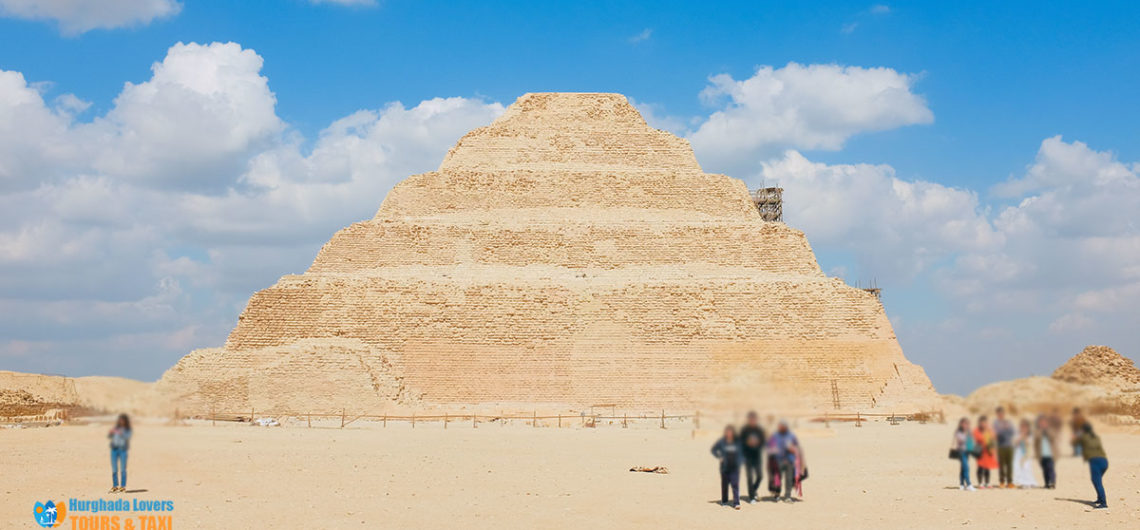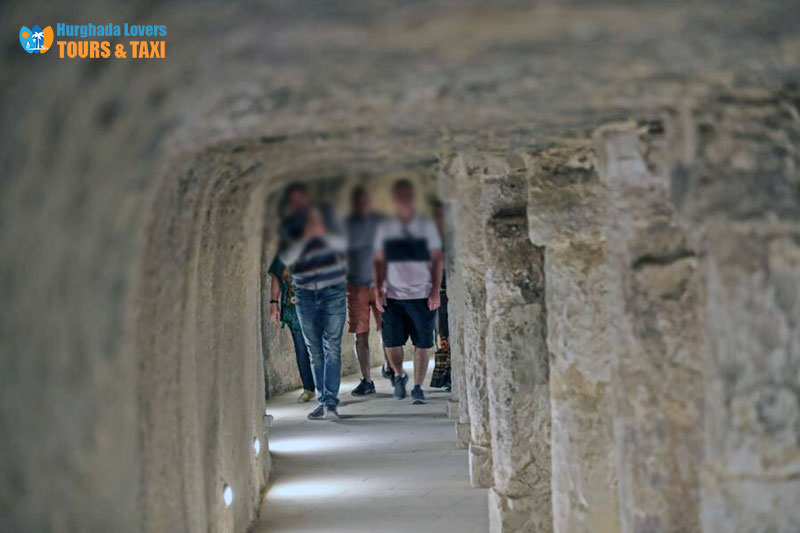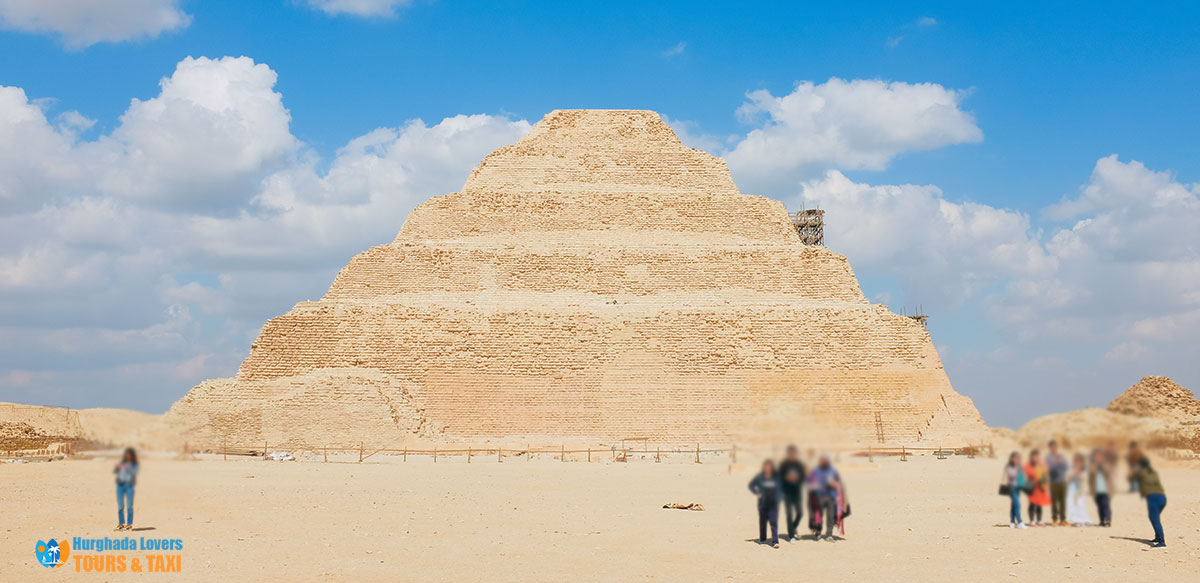Pyramid of Djoser in Saqqara Giza Egypt | Egypt’s First Pyramid – Egyptian Tombs
Discover the history of the Pharaonic civilization “Ancient Egypt History” to build the step pyramid, the oldest stone building in the ancient Egyptian civilization.
Information and secrets of the stages of building the pyramid terraces and the surrounding complex by the architect Imhotep “Egyptian Pharaohs” and planning the pyramid of King Djoser “Egyptian Pharaohs kings” from the inside and what it contains of secrets of Architecture in ancient Egypt and visiting tourist attractions in Giza in addition to tourist attractions in Cairo and learning about tourist attractions in Egypt that you did not know before about the Ancient Egypt civilization.
Pyramid of Djoser Facts
The pyramid of Djoser was built starting with one mastaba, then its construction was gradually completed until it reached 6 terraces, one above the other, with a successive geometric design..
The pyramid was built with the idea of the eternal hill of the Pharaohs and the beliefs of the beginning of creation in the Ancient Egyptian religion, where the spirit of the king ascends to the top of the pyramid “as a god or lord of creation” and then the spirit begins to ascend the stairs to the sky until it reaches the beginning of the sacred journey to the sun as in the legends of the Pharaohs “Egyptian Mythology“.
Many tunnels and catacombs were built under the pyramid complex of King Zoser, the most famous of the pharaohs of the Third Dynasty of Egypt of the Old Kingdom of Egypt, and more of them are being discovered every day until now by Egyptian and foreign archaeological missions..
Egyptian Temples, known as funerary Mortuary Temples and pharaonic shrines, were built for the annual pharaonic celebrations, “Festivals in Ancient Egypt,” especially the Pharaonic feast of the Lord, which King Zoser celebrated after thirty years of his rule in ancient Egypt “Ancient Egyptian Government” and the Coronation of the Pharaohs.
Huge walls were built around the Djoser pyramid complex and The Southern Tomb is decorated from above with wonderful geometric shapes similar to those found in the tombs of the Meccan family, the Umm El Qa’ab Tombs in Abydos, Sohag, and those found around the Saqqara mastabas..
Height: 62 m
Djoser Pyramid Base: 125 m * 109 m.
Material: Limestone
Architect: Imhotep
Construction date: 27th century BC.
What is the reason for building the pyramid of Djoser?
The main reason is the burial of King Zosra, one of the most famous pharaohs, after his death..
Royal Tombs of the King Zoser Dynasty.
In what era was the pyramid of Djoser built?
The Pyramid of Djoser was built during the reign of King Djoser..
What is the idea of building the pyramid of Djoser?
It seems that the architect Imhotep was inspired by the construction of the ziggurat in Mesopotamia first and then created this creative architectural work, as evidenced by the fact that he first built a tomb in Memphis consisting of six terraces, one on top of the other, among the most famous Egyptian tombs, and the size of the one above it is smaller than the one before it, so its external shape takes the shape of a pyramid, but it resembles a ziggurat..
It is believed that the method of building mastabas on top of each other to create the pyramids remained the basis even in The Pyramids of Giza “Great Pyramid of Giza, Pyramid of Khafre, Pyramid of Menkaure, The Sphinx of Giza” and here lies The Secrets of Pyramid Construction.
Imhotep’s creativity was to replace bricks with stones in building the mastabas, and this method was sufficient to preserve the pyramids over time while most of the ziggurats built from bricks and clay collapsed, indicating the development of Ancient Egyptian science.
What is the importance of the pyramid of Djoser?
The Pyramid of Djoser is considered the first huge stone building in the history of Egyptian architecture in the era of the Pharaohs. The entrance hall, the Royal Jubilee Temple, and the funerary temple were attached to this pyramid, indicating the development of Sculpture in Ancient Egypt.
Innovation and renewal are also evident in the group of funerary buildings and the temple attached to the pyramid.
It is noted that Imhotep derived from Ancient Egyptian Papyrus the stone half-columns attached to the wall, and inspired from bundles of reeds the columns attached to the wall of some other buildings, and maintained the imitation of the wooden columns in the stones of the ceiling of the entrance hall..
Facts about the Pyramid of Djoser:
- The pyramid was covered with a layer of polished white limestone (Ancient Egyptian Metallurgy) when it was built..
- The step pyramid or stone building in the 27th century BC.
- The Saqqara pyramid was affected by a strong earthquake in 1992 AD. Large parts of the funerary complex fell from the pyramid..
- The Pyramid of Djoser is considered the oldest pyramid in the history of the Egyptian Pharaonic civilization and throughout history..
- The Step Pyramid is considered the beginning of the architectural development in the ancient Egyptian civilization..
- The Pyramid of Djoser has uniquely carved facades as well as balconies..
- 3,330,400 cubic metres of stone and clay were used in the construction of the pyramid’s mastabas..
- The pyramid contains a 365-meter-long passage..
- The Pyramid of Djoser contains 400 underground rooms, including burial chambers and fake rooms to prevent the theft of the pharaohs’ Mummy by pharaonic tomb robbers “Ancient Egyptian Grave Robbers“.
- The pyramid contains 40 thousand pharaonic drawings on the walls of the long corridors inside the pyramid..
- Two pharaonic coffins “Ancient Egyptian Coffins” were discovered, containing the bones of a woman, indicating the development of Medicine in ancient Egypt and Mummification in ancient Egypt.
- The pyramid was covered with a smooth shell of white limestone..
- 200,000 tons of stone were used to build Mastaba No. 5 and 6..
- The ancient Egyptians were the first to use stone cutting technology in 2650 BC..
Who is the architect of the pyramid of Djoser?
The engineer Imhotep is considered the general supervisor of the construction of the step pyramid of King Djoser. The name of Imhotep was found on the base of the statue of King Djoser, in addition to the well-known Djoser group, which illustrates the art of construction in the Pharaonic era using stone..
It was built by the ancient Egyptian engineer, astronomer, priest, writer and sage (Imhotep) who became a minister to King Zoser and whose name remained immortal throughout the ages and was even worshipped in some later ages.
The Greeks considered him the god of medicine, science and engineering among the most famous ancient Egyptian deities – Ancient Egyptian gods and Goddesses.
What are the reasons for choosing the Saqqara site to build the pyramid?
The Saqqara area was close to the pharaonic tombs of the First Dynasty of Egypt and the mastabas of the Second Dynasty of Egypt, so King Zoser chose the area as a funerary city to build his own tomb in the form of a large pyramid..
Who discovered the pyramid of Djoser?
Von Minutoli obtained permission from Muhammad Ali Pasha to transport the antiquities discovered in the Step Pyramid to Germany, but the Gottfried’s ship sank completely at the bottom of the ocean as a result of Hurricane Shedd..
The entrance to the pyramid of Djoser was discovered in 1821 AD by the German Consul General Heinrich von Miottoli and the Italian engineer Girolano Segato..
The remains of a pharaonic mummy were found, of which only a skull and the heels of the feet covered in pure gold remained..
Chambers, passages and a group of pharaonic mummies were discovered in the pyramid in 1837 AD, through the excavation mission of the archaeological researcher and Egyptology John Bering..
Excavations continued inside the pyramid, starting with Egyptologists Cecil Firth in 1926 AD, then James Keble, then Jane Lauer, until 1934 AD, when the main tomb chamber of the pyramid was found, containing the remains of many mummies, which turned out to be for a group of people buried in the tomb from the Ptolemaic Kingdom.
The wall surrounding the Djoser Pyramid in the courtyard of the Step Pyramid was restored under the leadership of archaeologist Lauer Makrtha..
A group of tunnels were discovered under the pyramid by a mission from Lithuania in 2001 AD..
Step pyramid layout:
The base of the step pyramid is rectangular and consists of 6 terraces and has an external facade containing vertical cavities. Inside you will find engravings, drawings and columns connected to each other and containing vertical openings in addition to columns with capitals in the shape of an open The Egyptian Lotus Flower. You will also find engravings on the wall in a horizontal line..
Step Pyramid Construction Stages:
The Djoser pyramid was built in 6 stages. The first stage involved building the first mastaba, then 5 other stages involved building each mastaba separately, until it finally became a 6-tiered pyramid..
The first stage:
The first platform was built of limestone and then an outer covering of evening stones..
A corridor was built to the burial chamber of King Zoser..
Length of the platform: 63 meters
Height: 8 meters
Phase 2:
The second terrace was built and contains 11 balconies facing east..
Side length: 72 meters
Height: 7 meters
Stage 3:
The third mastaba was built to cover the corridors and vestibule of the eastern part of the pyramid..
Side length: 80 meters
Height: 5 meters.
Stage Four:
The pyramid of Djoser was built with 3 steps on top of each other, with each side measuring 86 meters x 77 meters..
The stones were added at a 17 degree angle to cover the main body of the pyramid, while connecting them to appear strong and cohesive..
Stage Five:
The pyramid was covered with a base of 119 meters * 107 meters, an entrance was built in the northern direction and a funerary temple was built above ground next to it in addition to covering the main entrance to the step pyramid..
Stage 6:
The pyramid was expanded until the length of the side became 121.8109 meters, with 6 steps and a height of 63 meters, with an architectural design so that the external shape of the pyramid was flat after adding the steps in an arched shape..
Step Pyramid Infrastructure:
It contains the king’s sarcophagus chamber in the Djoser pyramid, an entrance and rooms covered with faience, in addition to 11 corridors with underground passages and a group of wells..
The king’s burial chamber consists of red granite underground, 28 meters deep, measuring 7*7 meters. You will see a room that directs you to the king’s burial chamber through an opening with a diameter of 1 meter..
The main entrance was closed with a large piece of granite weighing approximately 4 tons. The walls of the king’s burial chamber and the maneuvering room were decorated with stones and then a layer of sand..
A group of corridors were built, connected to a group of hallways, around the burial chamber of King Zoser. After passing through the eastern hallway, you will see 4 rooms covered with blue faience and frames in the form of curtains..
The blue vine meant to the ancient Egyptians the waters of the afterlife after death, and it was also believed in the Egyptian religious beliefs of the pharaohs..
You will see 3 wall engravings of King Djoser during the official celebrations of the Sed Festival..
You will see that the burial chamber of King Zoser is covered with four layers of red granite..
A statue of the king was found in the burial chamber, in addition to the mummy and coffin of King Djoser..
You will notice that the pyramid of King Djoser is surrounded by shrines for worship and a group of underground corridors connected to each other 27 meters below the ground..
Djoser Pyramid Complex at Saqqara:
The Djoser Pyramid Complex is considered one of the largest complexes in Egypt, as it contains buildings for celebrations and official holidays in addition to funerary temples for the worship of ancient Egyptian religious beliefs..
The pyramid
Southern Cemetery
Eid altars
The temple
South Square
South cabin
North cabin
Funerary temple
Western corridors
Column Hall
North Square
Northern warehouses
Northern corridors
The crypt
North Altar
The Big Trench:
A trench 40 metres wide and 750 metres long was built around the pyramid of King Djoser. The trench is currently completely covered with sand..
You will notice the Pyramid of Userkaf, built during the reign of king Userkaf of the Fifth Dynasty of Egypt, and the Pyramid of Unas, built during the reign of king Unas, on the sides of the moat surrounding the step pyramid..
The wall:
A large wall was built around the Djoser pyramid complex, 1645 meters long and 11 meters high, made of limestone, in addition to building 14 doors inside the wall and building a main entrance from the south-east direction..
The complex was built on an area of approximately 30 acres, with a length of 545 meters and a width of 278 meters..
A stone gate and tower were built every 4 metres..
Main entrance:
The main entrance to the complex was built with an entrance door and a columned hall consisting of 20 pairs of stone columns 6 metres high..
You will see the design of the columns in the form of longitudinal plant stems, which represent niches. Then, in the western direction, we find the southern courtyard containing 4 columns. Remains of a statue of King Zoser were found, in addition to a group of papyri containing texts confirming that the engineer Imhotep was the one who designed and supervised the construction of the pyramid and the entire surrounding complex..
The interior design of the entrance was reconstructed by archaeologist Philip Lauer between 1946 and 1956 AD..
Southern Tomb of Djoser Complex:
The tomb was built of limestone in a rectangular shape and red granite. It has a special prayer niche and drawings of cobra heads at the entrances and ceilings of the tomb..
There is an entrance in the tomb that directs you to a burial chamber about 2 meters long and contains a maneuvering room similar to the same maneuvering room in the step pyramid, then a passage that leads to a corridor decorated with blue faience on the walls and drawings of King Djoser on the false doors during his celebration of the Sed Festival..
The reason for building the southern tomb in the complex has not yet been determined. Is it a fake tomb? Is it a spare tomb? Is it a miniature tomb of King Djoser? Was it actually used for burial?
Sed Festival Square:
The courtyard hosted official celebrations of King Zoser’s presence for the Sed Feast..
The courtyard is designed in a square shape containing 13 niches dedicated to worship..
The mihrab was designed in the shape of a sih-nethir, meaning the shadow of the god, so that the ceiling was flat and the letter arched outwards like palm branches, in addition to another design called the barwi with an arched ceiling, columns on the walls, and false doors to mislead tomb robbers..
You will see 12 niches in the eastern direction, built for the celebrations of King Djoser in the afterlife after his death..
Temple of Ti:
The temple was discovered by archaeologist Jane Lauer. The temple was built of polished stone blocks..
The temple is a small hall with columns at the entrance and contains a front room, a square hall, 3 internal halls and a limestone ceiling supported by columns..
Funerary temple:
The temple was built of white limestone to sanctify King Zoser in the northern direction of the pyramid. The temple consisted of a wooden door, then two columns, several internal rooms, and a courtyard in the western direction with a secret staircase leading to the pyramid from the inside, and another courtyard in the eastern direction..
Remains of statues of King Djoser were found next to the funerary temple..
The crypt:
The secret crypt in the pyramid of Djoser consists of a room of polished stones at an angle of 17.
Inside the crypt was found a full-size limestone statue of King Djoser sitting on a throne..
South cabin:
There are currently only remains of the cabin and the entrance, which was designed with a roof supported by columns, with each row containing 4 columns and coloured red and black like cedar trees..
In the cabin you will find a prayer niche in addition to Pharaonic drawings and engravings. Burnt papyri and manuscripts from the New Kingdom era of ancient Egyptian civilization were found..
North cabin:
It contains a small courtyard and a well for a large underground hall..
Western galleries in the Djoser complex:
The three corridors were built from the remains of the step pyramid stones..
Under the arcades are 400 rooms, which were used as storerooms and graves, some of which were fake to mislead grave robbers..
Djoser Pyramid Address:
Desert Back, Giza, Egypt.
Visiting hours:
Daily 08:00 AM – 05:00 PM
Entrance ticket prices:
Entrance ticket price for foreign tourists to the Djoser Pyramid = Egyptian pounds
Entrance ticket price for foreign students = Egyptian pounds
Entrance ticket price for Egyptians = Egyptian pounds
Entrance ticket price for Egyptian student = Egyptian pounds
Note: Facts and secrets of the history will be added soon…
Hurghada Excursions Lovers, Best Travel Agency in Hurghada to provide daily tours to visit the Tourist attractions of Luxor by Hurghada to Luxor Tours and Hurghada to Pyramids Trips. Book online when you come to Hurghada, El Gouna, Sahl Hashish, Makadi Bay, Soma Bay.
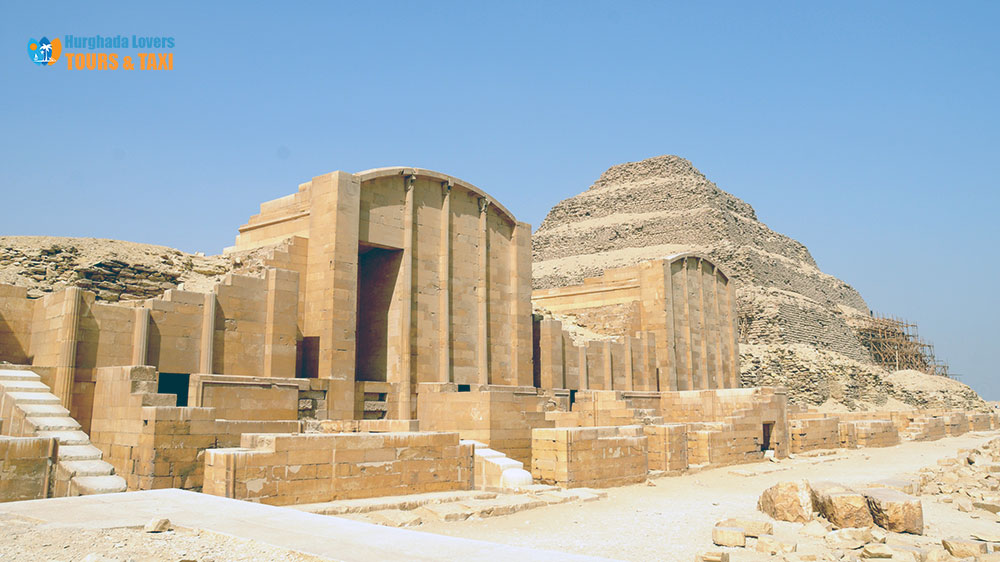
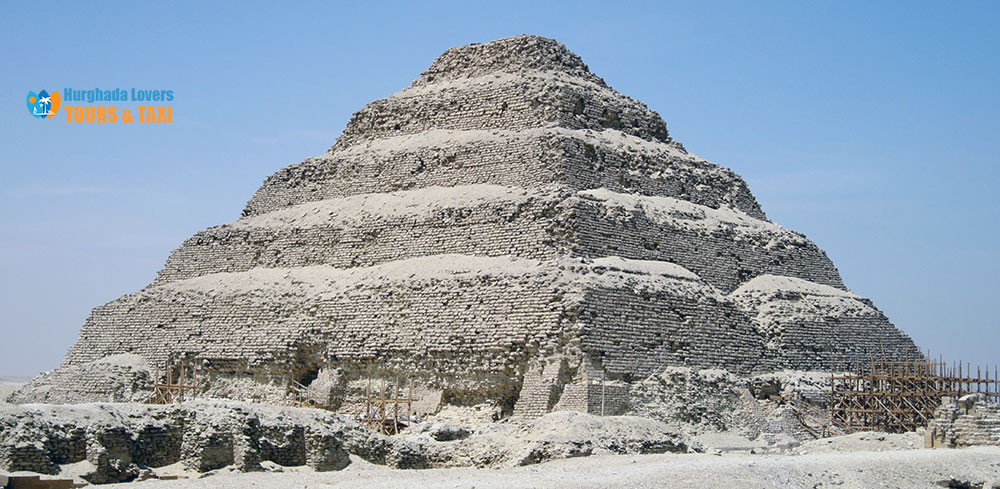
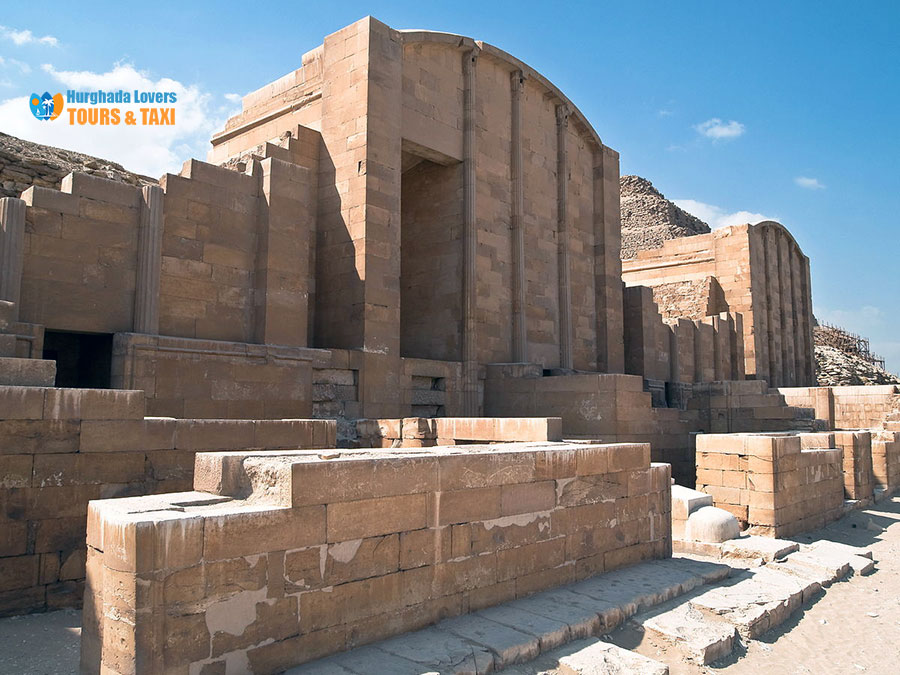
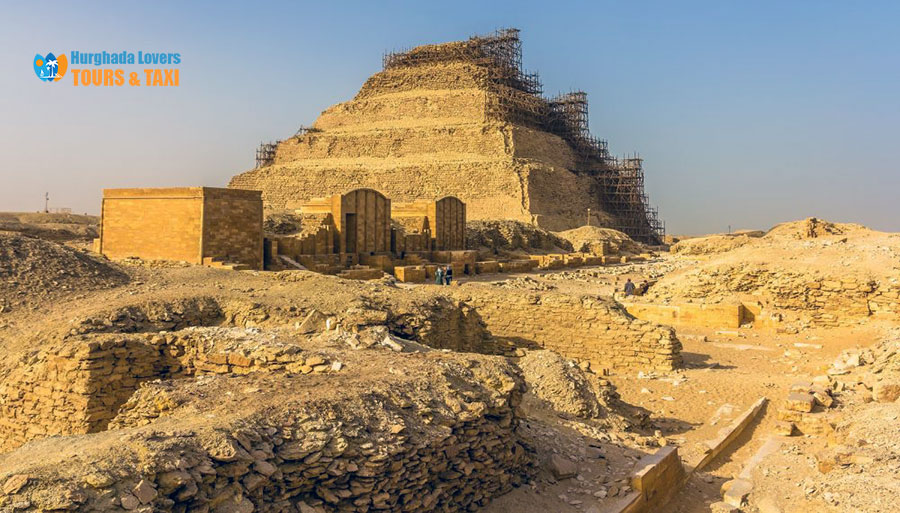
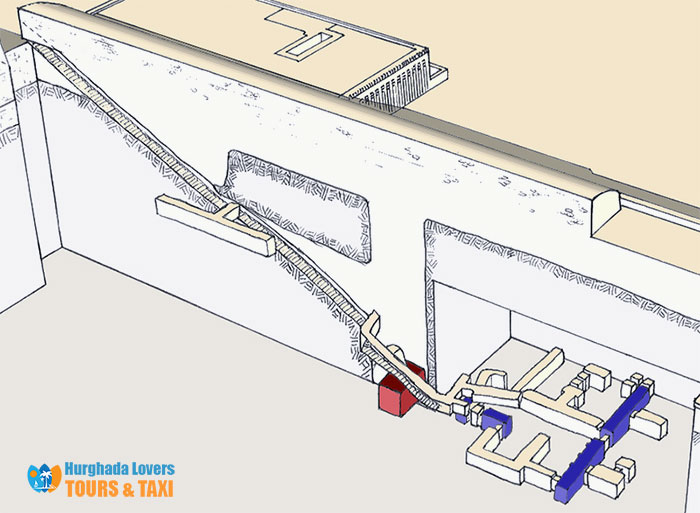
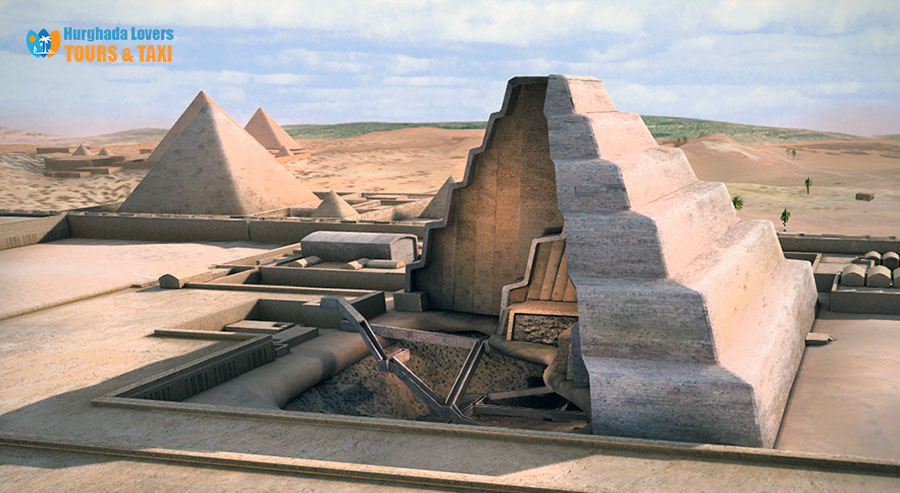
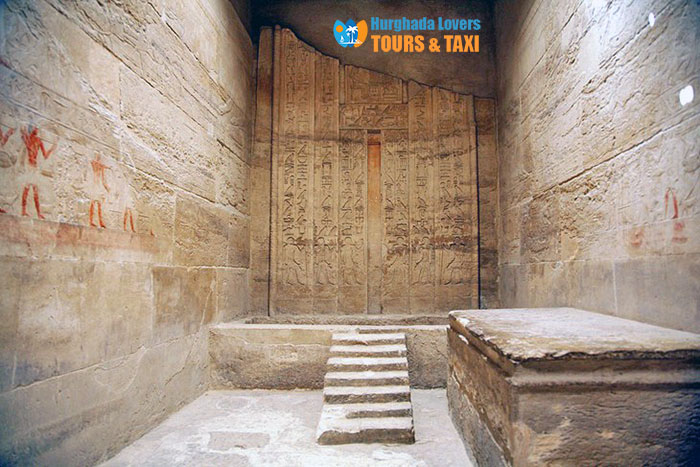

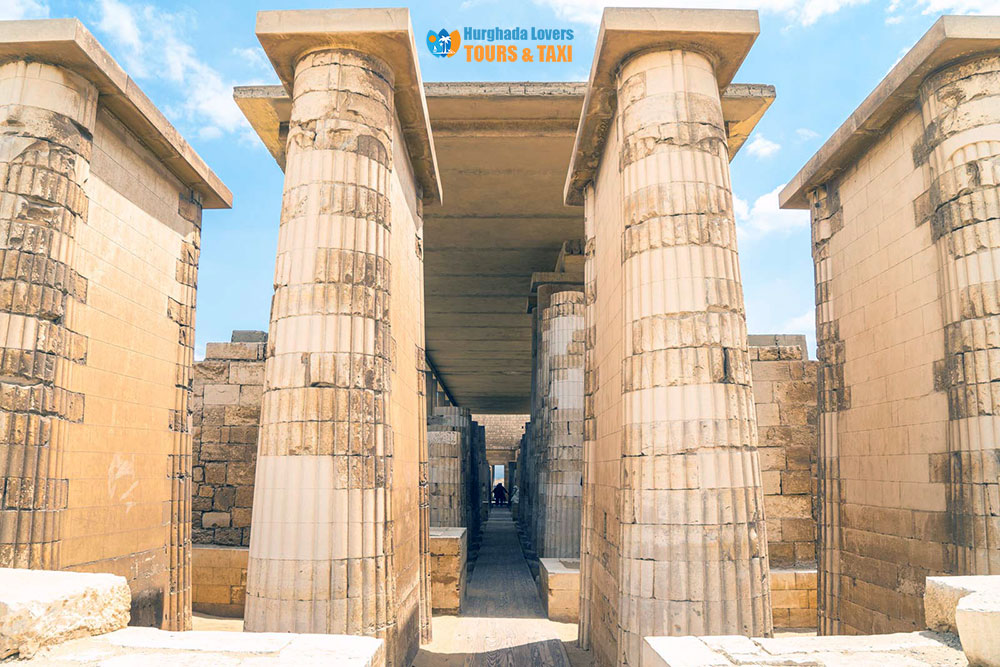
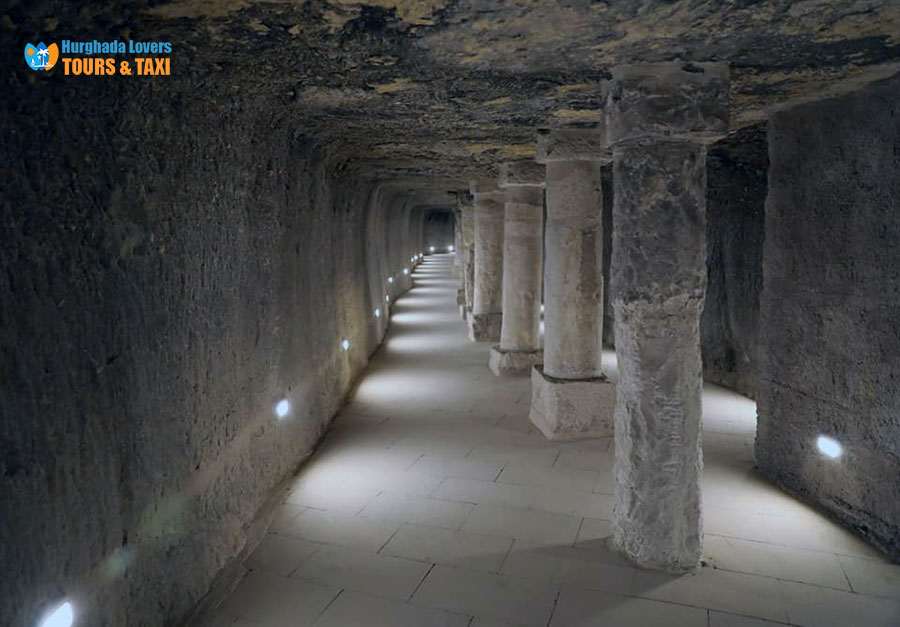

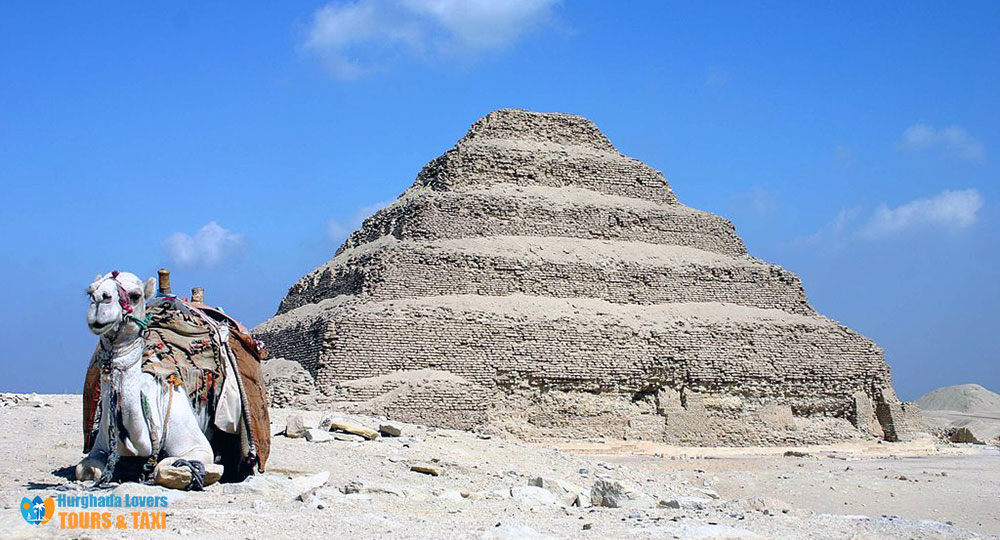
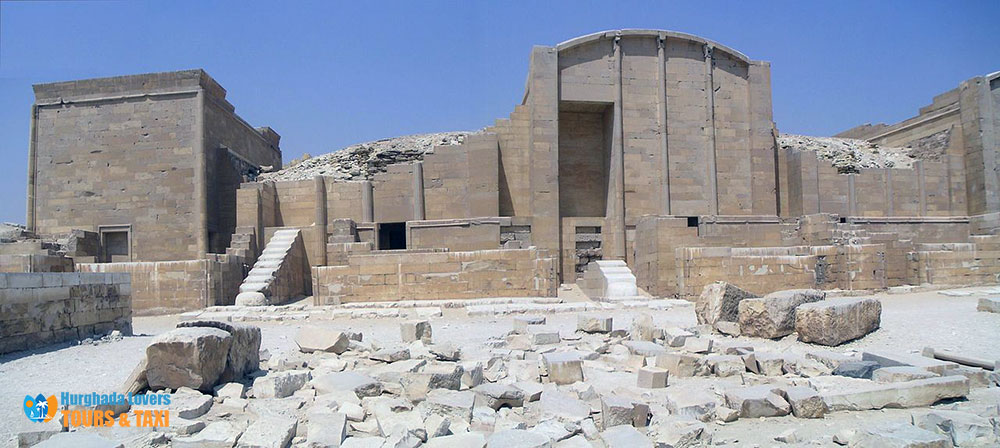
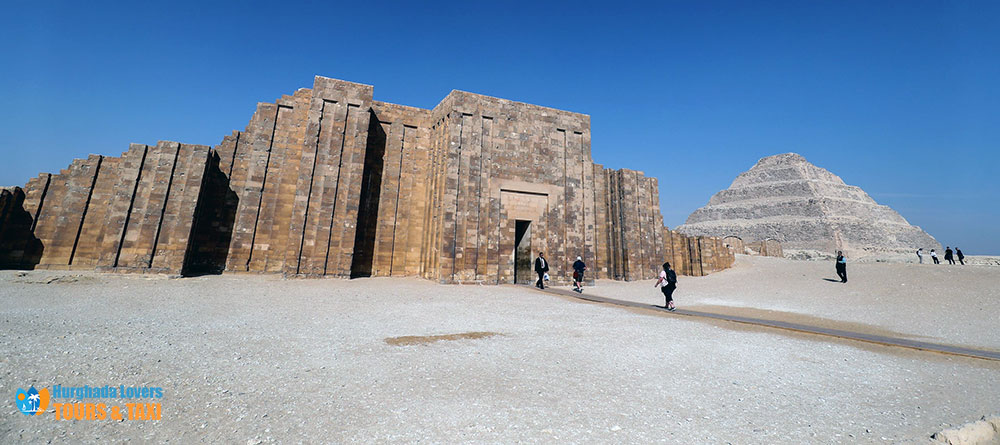
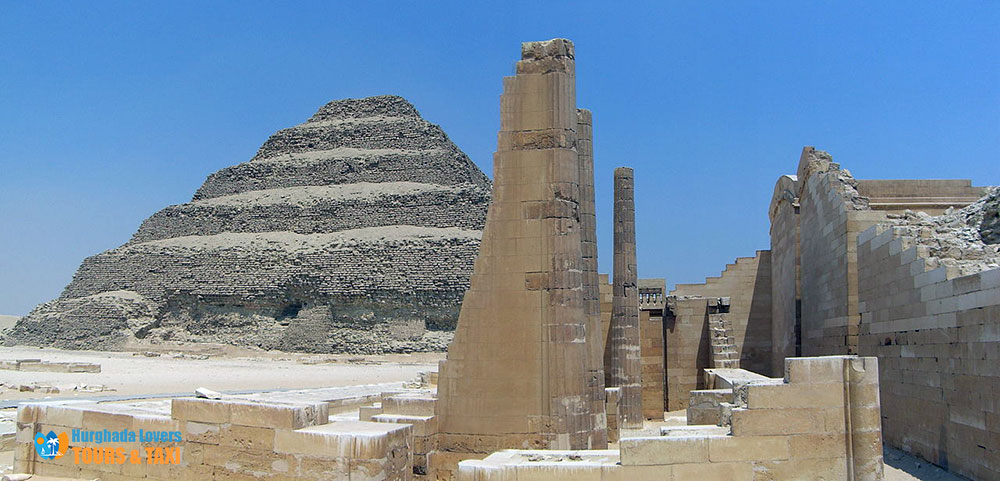
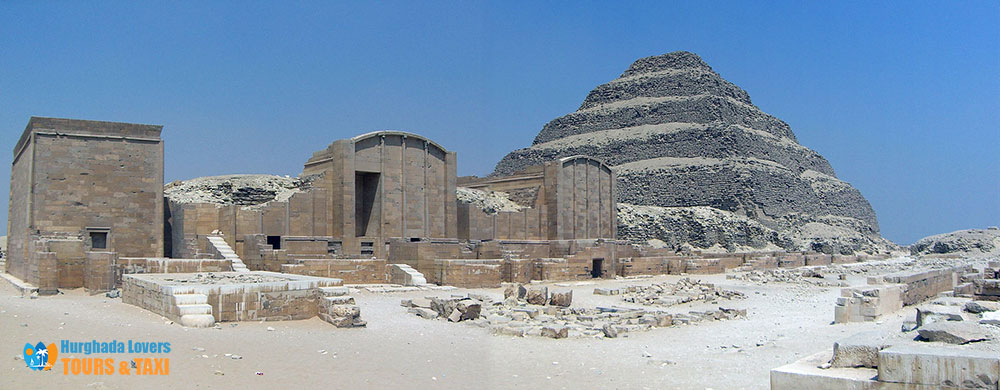

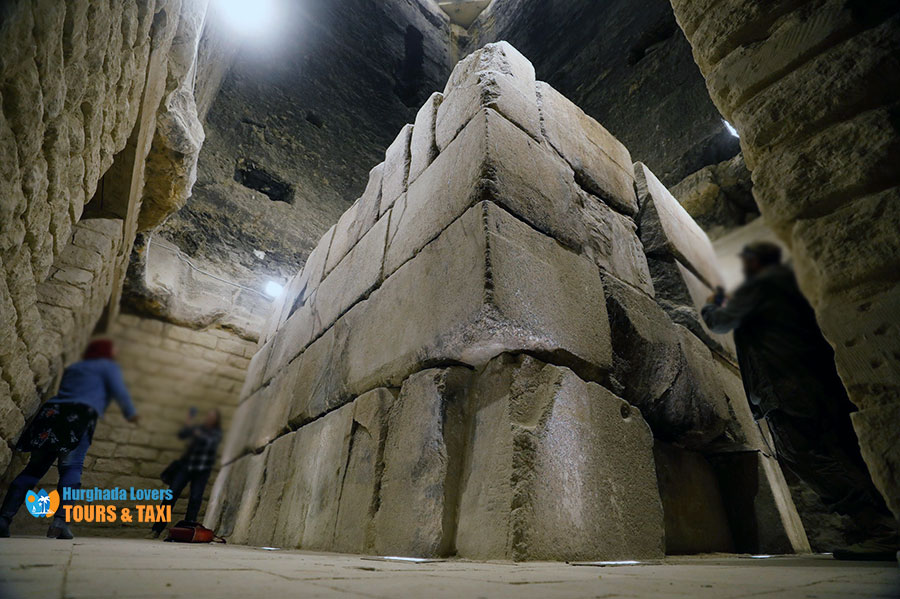
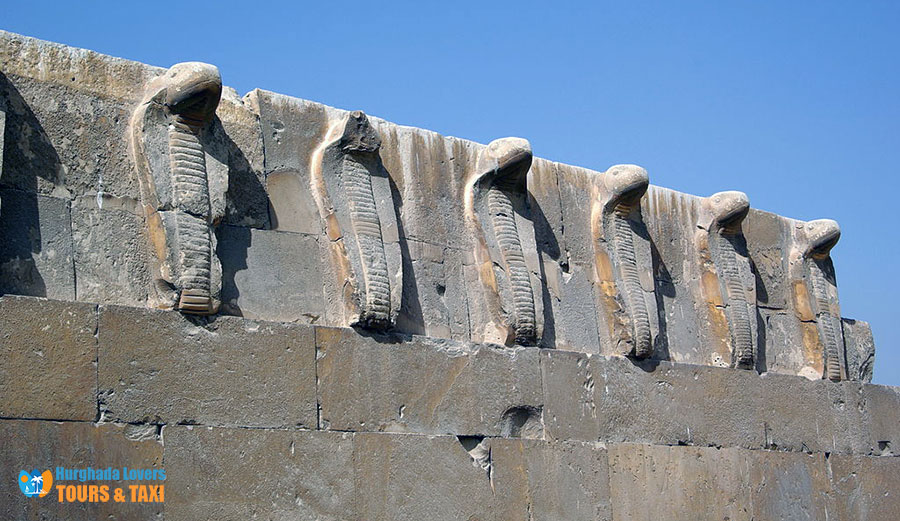
Pyramid of Djoser in Sakkara Giza Egypt | Step Pyramid of King Djoser
